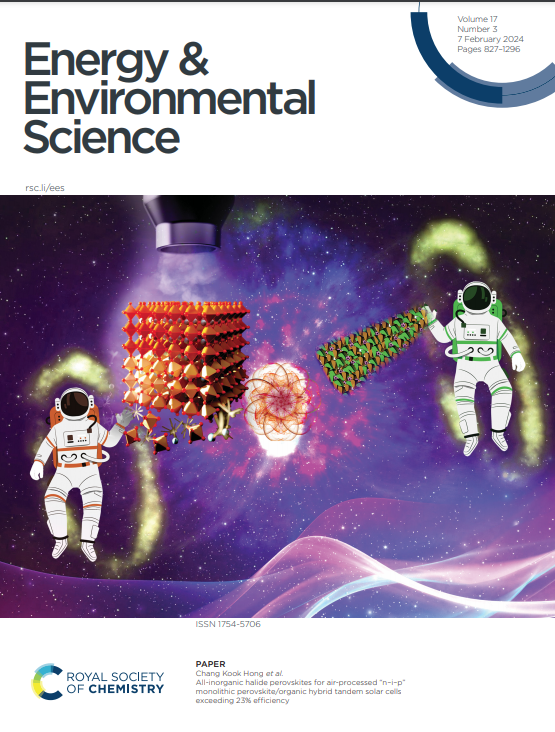Carbonyl-based organic electrode materials spanning from nonaqueous rechargeable lithium to calcium batteries
IF 32.4
1区 材料科学
Q1 CHEMISTRY, MULTIDISCIPLINARY
引用次数: 0
Abstract
Electrochemical energy storage systems, particularly rechargeable batteries, show great potential in efficiently implementing intermittent renewable energies into a current energy network. In light of the superior natural abundant element and moderate specific energy, rechargeable calcium batteries (RCBs) have attracted wide attention, as complementary technology to the prevailing rechargeable lithium batteries (RLBs). However, calcium chemistry differs drastically from the existing lithium chemistry (e.g., electrochemical kinetics and potential), calling for ingenious design of key battery materials (e.g., electrodes and electrolytes). Carbonyl-based organic electroactive materials (OEMs) exhibit fast electrochemical kinetics, high reversible capacity and excellent capacity retention, being promising for constructing high-performance rechargeable batteries. In this work, the carbonyl-based compounds in either discrete or polymeric/immobilized forms, being utilized as OEMs for calcium and lithium-based rechargeable batteries, are scrutinized, with due consideration given to similarities and distinctions between two battery systems. Concentrating on carbonyl-based OEMs, significant impacts from electrode–electrolyte interphases/interfaces and electrolyte components are presented. Furthermore, the existing challenges and opportunities for improving the electrochemical performances of carbonyl-based materials in RCBs are provided. This work may serve as a spur for the practical deployment of sustainable and high-energy rechargeable batteries.

羰基有机电极材料,从非水可充电锂电池到钙电池
电化学储能系统,特别是可充电电池,在有效地将间歇性可再生能源纳入当前的能源网络中显示出巨大的潜力。可充电钙电池由于具有天然元素丰富、比能适中等优点,作为目前流行的可充电锂电池的补充技术而受到广泛关注。然而,钙化学与现有的锂化学(如电化学动力学和电势)有很大的不同,需要对关键的电池材料(如电极和电解质)进行巧妙的设计。羰基有机电活性材料(OEMs)具有快速的电化学动力学、高可逆容量和优异的容量保持能力,有望用于构建高性能可充电电池。在这项工作中,以离散或聚合/固定化形式的羰基化合物被用作钙基和锂基可充电电池的原始设备,被仔细审查,并适当考虑到两种电池系统之间的相似性和区别。重点介绍了基于羰基的原始设备制造商,介绍了电极-电解质界面/界面和电解质成分的重大影响。此外,还指出了羰基材料在rcb中提高电化学性能所面临的挑战和机遇。这项工作可能会促进可持续和高能可充电电池的实际部署。
本文章由计算机程序翻译,如有差异,请以英文原文为准。
求助全文
约1分钟内获得全文
求助全文
来源期刊

Energy & Environmental Science
化学-工程:化工
CiteScore
50.50
自引率
2.20%
发文量
349
审稿时长
2.2 months
期刊介绍:
Energy & Environmental Science, a peer-reviewed scientific journal, publishes original research and review articles covering interdisciplinary topics in the (bio)chemical and (bio)physical sciences, as well as chemical engineering disciplines. Published monthly by the Royal Society of Chemistry (RSC), a not-for-profit publisher, Energy & Environmental Science is recognized as a leading journal. It boasts an impressive impact factor of 8.500 as of 2009, ranking 8th among 140 journals in the category "Chemistry, Multidisciplinary," second among 71 journals in "Energy & Fuels," second among 128 journals in "Engineering, Chemical," and first among 181 scientific journals in "Environmental Sciences."
Energy & Environmental Science publishes various types of articles, including Research Papers (original scientific work), Review Articles, Perspectives, and Minireviews (feature review-type articles of broad interest), Communications (original scientific work of an urgent nature), Opinions (personal, often speculative viewpoints or hypotheses on current topics), and Analysis Articles (in-depth examination of energy-related issues).
 求助内容:
求助内容: 应助结果提醒方式:
应助结果提醒方式:


